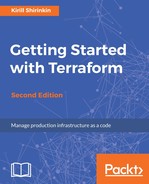Book Description
Build, Manage and Improve your infrastructure effortlessly.
About This Book
- An up-to-date and comprehensive resource on Terraform that lets you quickly and efficiently launch your infrastructure
- Learn how to implement your infrastructure as code and make secure, effective changes to your infrastructure
- Learn to build multi-cloud fault-tolerant systems and simplify the management and orchestration of even the largest scale and most complex cloud infrastructures
Who This Book Is For
This book is for developers and operators who already have some exposure to working with infrastructure but want to improve their workflow and introduce infrastructure as a code practice. Knowledge of essential Amazon Web Services components (EC2, VPC, IAM) would help contextualize the examples provided. Basic understanding of Jenkins and Shell scripts will be helpful for the chapters on the production usage of Terraform.
What You Will Learn
- Understand what Infrastructure as Code (IaC) means and why it matters
- Install, configure, and deploy Terraform
- Take full control of your infrastructure in the form of code
- Manage complete infrastructure, starting with a single server and scaling beyond any limits
- Discover a great set of production-ready practices to manage infrastructure
- Set up CI/CD pipelines to test and deliver Terraform stacks
- Construct templates to simplify more complex provisioning tasks
In Detail
Terraform is a tool used to efficiently build, configure, and improve the production infrastructure. It can manage the existing infrastructure as well as create custom in-house solutions.
This book shows you when and how to implement infrastructure as a code practices with Terraform. It covers everything necessary to set up the complete management of infrastructure with Terraform, starting with the basics of using providers and resources. It is a comprehensive guide that begins with very small infrastructure templates and takes you all the way to managing complex systems, all using concrete examples that evolve over the course of the book. The book ends with the complete workflow of managing a production infrastructure as code—this is achieved with the help of version control and continuous integration. The readers will also learn how to combine multiple providers in a single template and manage different code bases with many complex modules. It focuses on how to set up continuous integration for the infrastructure code.
The readers will be able to use Terraform to build, change, and combine infrastructure safely and efficiently.
Style and approach
This book will help and guide you to implement Terraform in your infrastructure. The readers will start by working on very small infrastructure templates and then slowly move on to manage complex systems, all by using concrete examples that will evolve during the course of the book.
Downloading the example code for this book. You can download the example code files for all Packt books you have purchased from your account at http://www.PacktPub.com. If you purchased this book elsewhere, you can visit http://www.PacktPub.com/support and register to have the code file.
